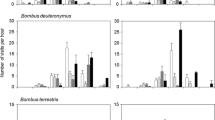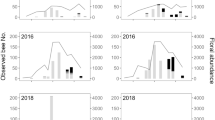Abstract
To assess the impact of Bombus terrestris invasion on the foraging efficiency of native Japanese bumblebees, consumption and acquisition of floral resources during foraging on flowers of native Japanese plant species were investigated using enclosures with three treatments: one with only B. terrestris (exotic), one with both B. terrestris and native Japanese bumblebee species (mixed), and one with only Japanese species (native), but with the bumblebee density held constant. Changes in the body mass of queens and the nest mass of colonies for two days did not significantly differ among four combinations of the species and treatment, B. terrestris in the exotic and mixed treatments and Japanese species in the mixed and native treatments. Thus, it is not clear that B. terrestris has higher foraging efficiency than native species and that B. terrestris individuals more negatively affect the foraging efficiency of native species than individuals of the native species themselves. The nectar standing crop of Cirsium kamtschaticum was smaller in the exotic treatment than in the mixed and native treatments. However, this may have been an artifact of differences in the numbers of flowers in the various treatments.
Similar content being viewed by others
References
Bowers MA (1985) Bumble bee colonization, extinction, and reproduction in subalpine meadows in northeastern Utah. Ecology 66:914–927
Estoup A, Solignac M, Cornuet JM, Goudet J, Scholl A (1996) Genetic differentiation of continental and island populations of Bombus terrestris (Hymenoptera: Apidae) in Europe. Mol Ecol 5:19–31
Goka K, Okabe K, Yoneda M, Niwa S (2001) Bumblebee commercialization will cause worldwide migration of parasitic mites. Mol Ecol 10:2095–2099
Goulson D (2003) Effects of introduced bees on native ecosystems. Annu Rev Ecol Evol Syst 34:1–26
Goulson D, Peat J, Stout JC, Tucker J, Darvill B, Derwent LC, Hughes WOH (2002a) Can alloethism in workers of the bumblebee, Bombus terrestris, be explained in terms of foraging efficiency? Anim Behav 64:123–130
Goulson D, Stout JC, Kells AR (2002b) Do exotic bumblebees and honeybees compete with native flower-visiting insects in Tasmania? J Insect Conserv 6:179–189
Graham L, Jones KN (1996) Resource partitioning and per-flower foraging efficiency in two bumble bee species. Am Midl Nat 136:401–406
Heinrich B (1979) Bumblebee economics. Harvard University Press, Cambridge
Hingston AB (2005) Does the introduced bumblebee, Bombus terrestris (Apidae), prefer flowers of introduced or native plants in Australia? Aust J Zool 53:29–34
Hingston AB, Marsden-Smedley J, Driscoll DA, Corbett S, Fenton J, Anderson R, Plowman C, Mowling F, Jenkin M, Matsui K, Bonham KJ, Ilowski M, McQuillan PB, Yaxley B, Reid T, Storey D, Poole L, Mallick SA, Fitzgerald N, Kirkpatrick JB, Febey J, Harwood AG, Michaels KF, Russell MJ, Black PG, Emmerson L, Visoiu M, Morgan J, Breen S, Gates S, Bantich MN, Desmarchelier JM (2002) Extent of invasion of Tasmanian native vegetation by the exotic bumblebee Bombus terrestris (Apoidea: Apidae). Aust Ecol 27:162–172
Hingston AB, McQuillan PB (1999) Displacement of Tasmanian native megachilid bees by the recently introduced bumblebee Bombus terrestris (Linnaeus, 1758) (Hymenoptera: Apidae). Aust J Zool 47:59–65
Inari N, Nagamitsu T, Kenta T, Goka K, Hiura T (2005) Spatial and temporal pattern of introduced Bombus terrestris abundance in Hokkaido, Japan, and its potential impact on native bumblebees. Popul Ecol 47:77–82
Ings TC, Schikora J, Chittka L (2005) Bumblebees, humble pollinators or assiduous invaders? A population comparison of foraging performance in Bombus terrestris. Oecologia 144:508–516
Kudo G, Maeda T, Narita K (2001) Variation in floral sex allocation and reproductive success within inflorescences of Corydalis ambigua (Fumariaceae): pollination efficiency or resource limitation? J Ecol 89:48–56
Macfarlane RP (1995) Distribution of bumblebees in New Zealand. N Z Entomol 18:29–36
Maloof JE (2001) The effects of a bumble bee nectar robber on plant reproductive success and pollinator behavior. Am J Bot 88:1960–1965
Matsumura C, Yokoyama J, Washitani I (2004) Invasion status and potential ecological impacts of an invasive alien bumblebee, Bombus terrestris L. (Hymenoptera: Apidae) naturalized in southern Hokkaido, Japan. Glob Environ Res 8:51–66
Nagamitsu T, Yoneda M, Mukose T (2000) Flower switching during consecutive foraging trips of Bombus ardens workers (Hymenoptera: Apidae). Entomol Sci 3:57–63
Nakajima M, Matsumura C, Yokoyama J, Washitani I (2004) Nesting in Bombus terrestris (Linnaeus) and foraging by B. terrestris workers from a B. hypocrita sapporoensis (Cockerell) nest in Mukawa-cho, Yufutsu-gun, Hokkaido, Japan. Jpn J Conserv Ecol 9:57–63
Ohara M, Higashi S (1994) Effects of inflorescence size on visits from pollinators and seed set of Corydalis ambigua (Papaveraceae). Oecologia 98:25–30
Peat J, Goulson D (2005) Effects of experience and weather on foraging rate and pollen versus nectar collection in the bumblebee, Bombus terrestris. Behav Ecol Sociobiol 58:152–156
Ruz L, Herrera R (2001) Preliminary observations on foraging activities of Bombus dahlbonmii and Bombus terrestris (Hym: Apidae) on native and non-native vegetation in Chile. Acta Hort 561:165–169
R Development Core Team (2005) R: A language and environment for statistical computing. R Foundation for Statistical Computing. Vienna, Austria. http://www.R-project.org
Spaethe J, Weidenmueller A (2002) Size variation and foraging rate in bumblebees (Bombus terrestris). Insect Soc 49:142–146
Thomson D (2004) Competitive interactions between the invasive European honey bee and native bumble bees. Ecology 85:458–470
Acknowledgements
The authors would first like to thank the 10 technical staff at Tomakomai Experimental Forest (TOEF) for making the bee keeping room and nest boxes, preparation of plants, and constructing the greenhouses. We also thank Mr M. Yoneda (API Co. Ltd.), Mr M. Mitsuhata (Arysta Lifescience Co.) and Ms S. Niwa for technical information on bee keeping, and API Co. Ltd. for providing bees, pollen and nest boxes. Eleven students in TOEF kindly helped with fixing nets on the greenhouses. Drs G. Kudo and H. Ishii kindly gave information on availability and reproduction of bumblebee-pollinated plants. Drs L. D. Harder and T. T. Makino are thanked for editorial assistance with the manuscript. This work was supported by Global Environmental Research Fund (director, K. G.), MESSC Grant-in Aid 15208014 and 16770020, and JSPS fellowship for young scientists to T. K.
Author information
Authors and Affiliations
Corresponding author
Additional information
T. Nagamitsu and T. Kenta contributed equally to this work
Rights and permissions
About this article
Cite this article
Nagamitsu, T., Kenta, T., Inari, N. et al. Foraging interactions between native and exotic bumblebees: enclosure experiments using native flowering plants. J Insect Conserv 11, 123–130 (2007). https://doi.org/10.1007/s10841-006-9025-x
Received:
Accepted:
Published:
Issue Date:
DOI: https://doi.org/10.1007/s10841-006-9025-x




